Coins Play a Central Role in the Splinter Politics of 1896
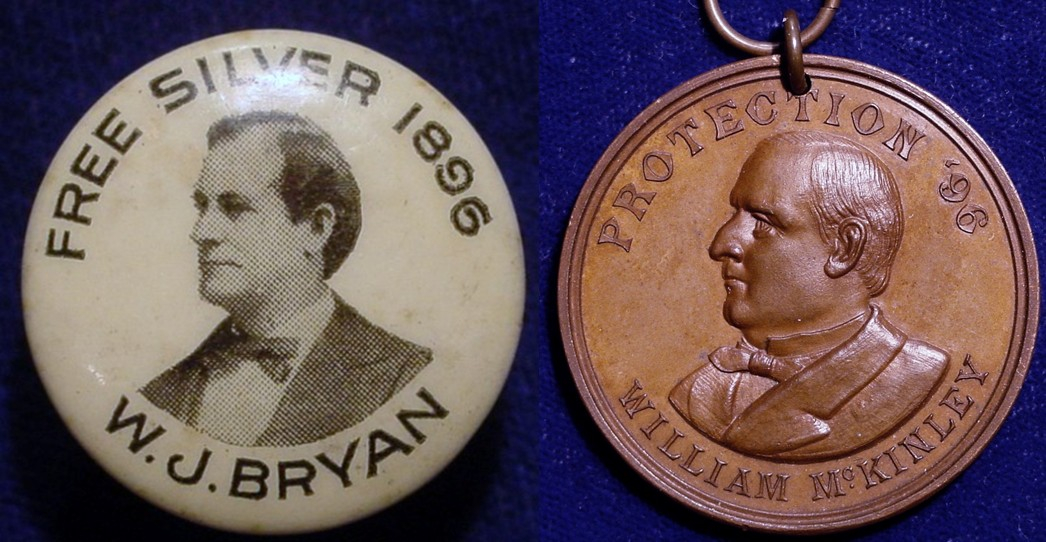
In 1896, and to a lesser extent 1900, coins played a major role in the presidential election campaigns. The major issue was what role would silver play in our nation’s monetary system? The Democrats, lead by William Jennings Bryan, advocated the free coinage of silver, in unlimited quantities, at a ratio of 16 parts silver to one part gold. The Republicans, with William McKinley carrying their banner, pushed to have the country remain on the Gold Standard.
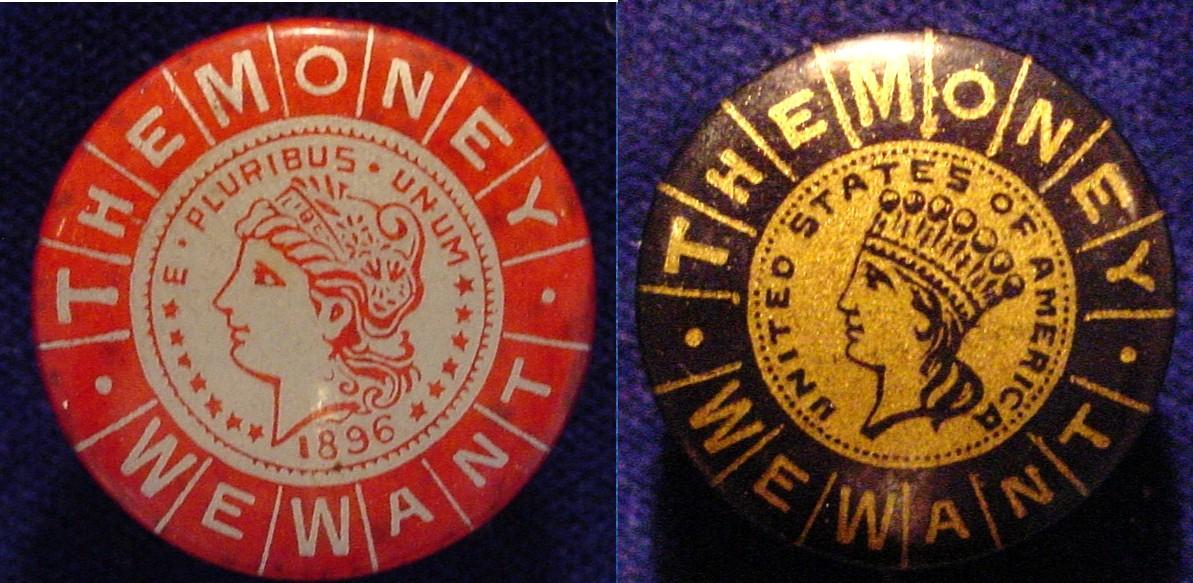
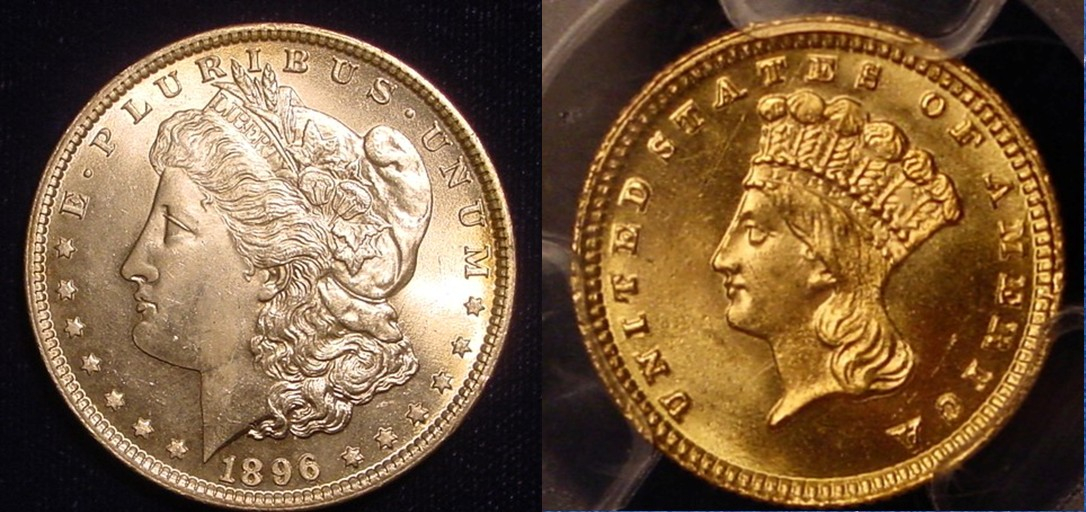
These two campaign pieces illustrated the kind of money that each side wanted. For the Democrats, it was a Morgan Dollar and for the Republicans it was a gold dollar. As coins, it’s much easier to find a Morgan Dollar than a gold dollar, but between these two political pieces, the Morgan Dollar stud is much scarcer.
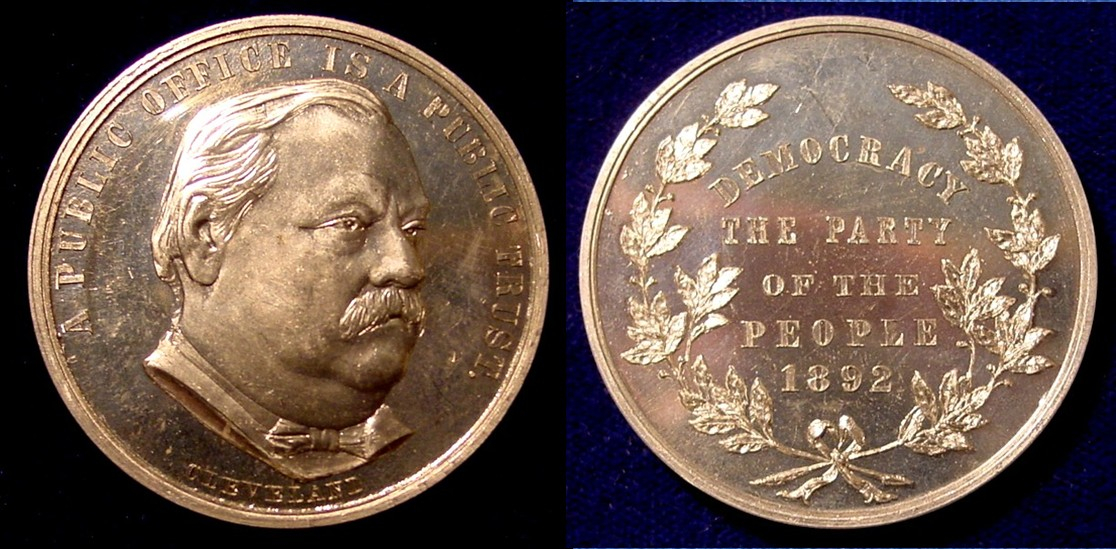
Outgoing president, Grover Cleveland, who was a Democrat, was a strong supporter of the Gold Standard.
Although the two parties were fairly well united, each of them had splinter groups that did not agree with the monetary policies of their central committees. Outgoing president, Grover Cleveland, supported the Gold Standard and was appalled at the direction his party had taken. A small faction, who called themselves “The National Democratic Party” agreed with him. They were informally known as the “Gold Democrats.”
The Gold Democrats supported the Gold Standard, but they did not agree with the protectionist tariff policies that the Republicans had supported for many years. They called for smaller government and a sound currency. They labeled the free silver position that the main Democratic Party had taken as reckless and irresponsible.
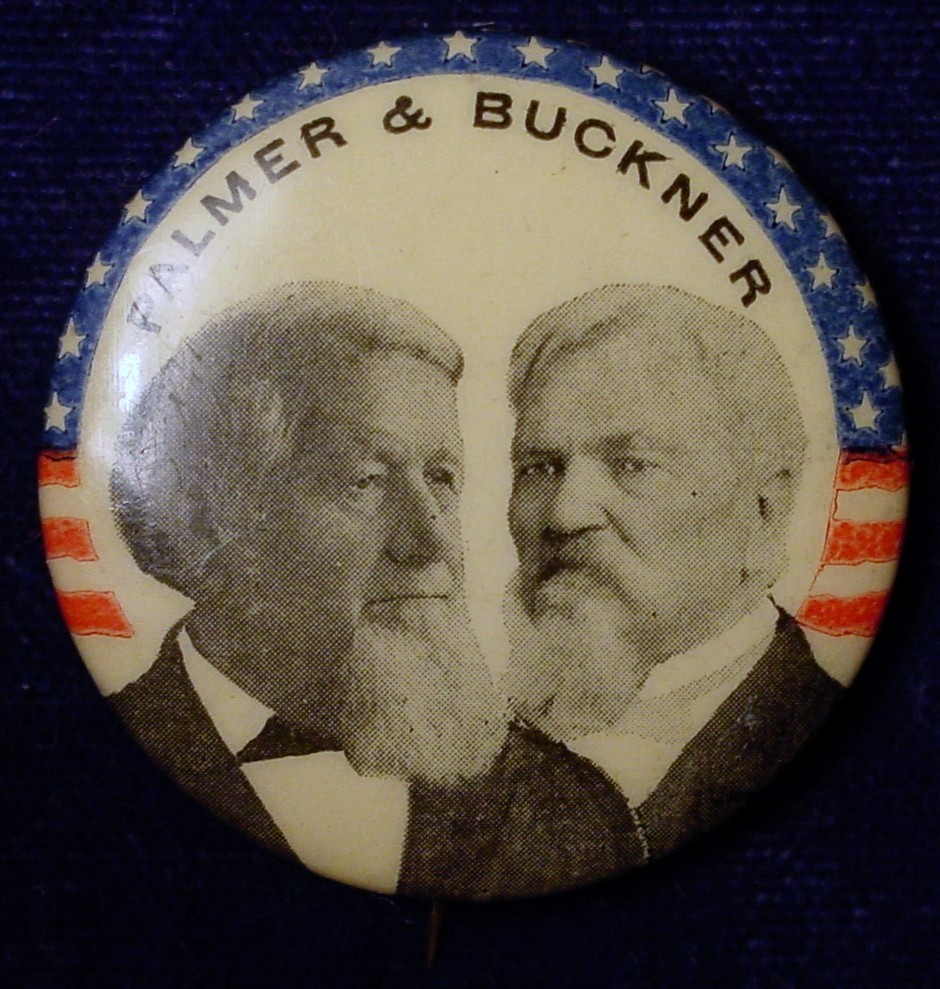
The National Democratic Party Nominates Their Candidates
The National Democrats held a convention in Indianapolis, Indiana. There were delegates from 41 of the 45 states and three territories. They nominated John M. Palmer of Illinois for president and Simon P. Buckner from Kentucky for vice president.
Palmer was a most interesting 19th century political gadfly. He began his political career as a Democrat, but switched to the Republican Party when it was formed to oppose admission of Kansas and Nebraska as slave states. During the Civil War he served in the Army raising to the rank of brigadier general in the regular Army and a major general in the volunteer service. He returned to politics after the war and was elected Governor of Illinois.
In 1872 he opposed the nomination of U.S. Grant for a second presidential term and joined the ranks of the Liberal Republicans who supported Horace Greeley for president. Ultimately, he returned to the Democratic Party and served one term in the Senate from 1891 to 1897. He died in 1900 at the age of 83. His running mate, Simon Buckner, was also a general during the Civil War, but for the Confederacy. He also served as Governor of Kentucky after the war.
In the general election, the National Democrats polled only 134,635 votes, which was less than 1% of the total. They had an influence in the outcome of the election, however. Between their votes and the disaffected Democrats who stayed home, the total might well have cost Bryan the 1896 presidential election.
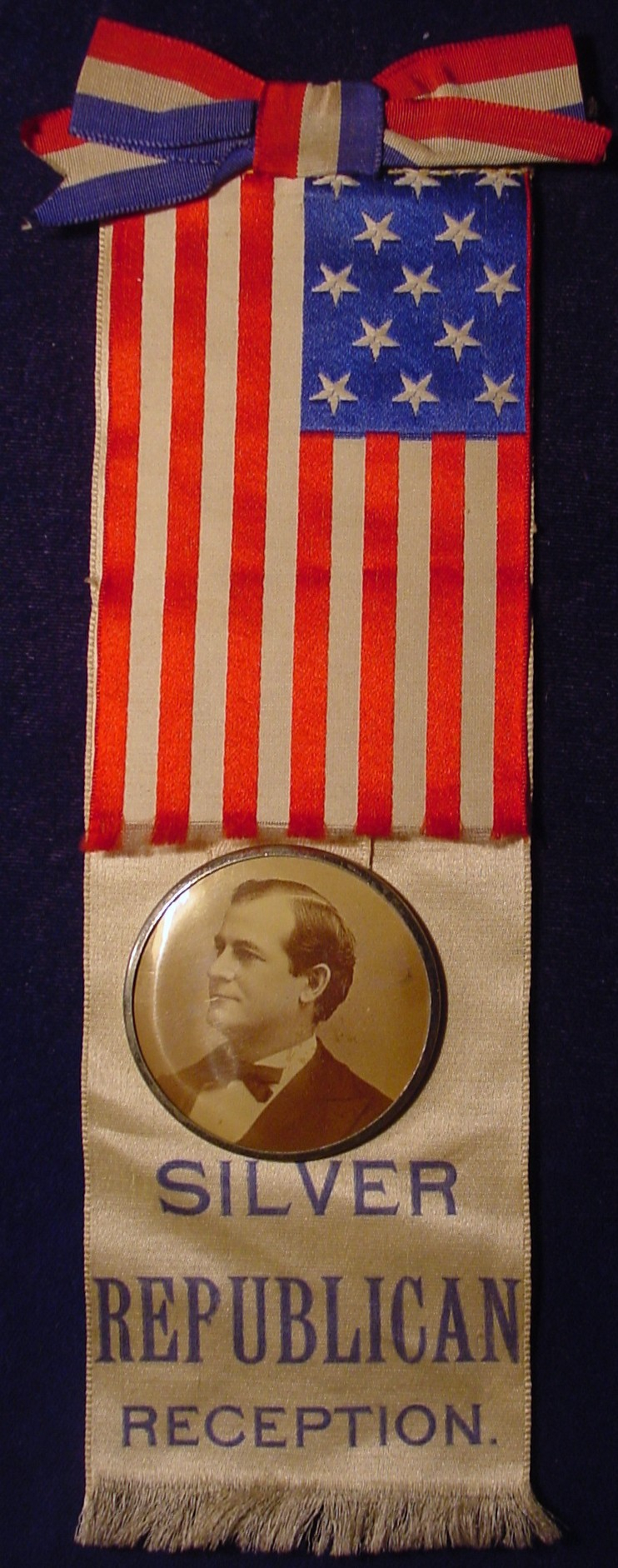
An attractive campaign ribbon, issued by the Silver Republicans, endorsed William Jennings Bryan.

The Silver Republican Party
Although they were far rarer birds, there was also a silver faction in the Republican Party. At 1896 Republican Convention, the party platform called for the Gold Standard. It could only be modified if there were an international agreement to change it. That agreement, which would have to be among the leading industrial nations of the world, would have called for the adoption of the bimetallic monetary system. While the Republicans stated that enacting such an agreement would be a priority, they knew that there was no chance that the other industrial powers would agree to it. Therefore, it was a hollow pledge.
Senator Henry Teller of Colorado offered an amendment. It called for the unrestricted and independent coinage of gold and silver at the U.S. mints at the ratio of 16 parts silver to one part of gold. The platform committee leadership moved to table Teller’s motion which, in reality, killed it. The convention nominated William McKinley for president.
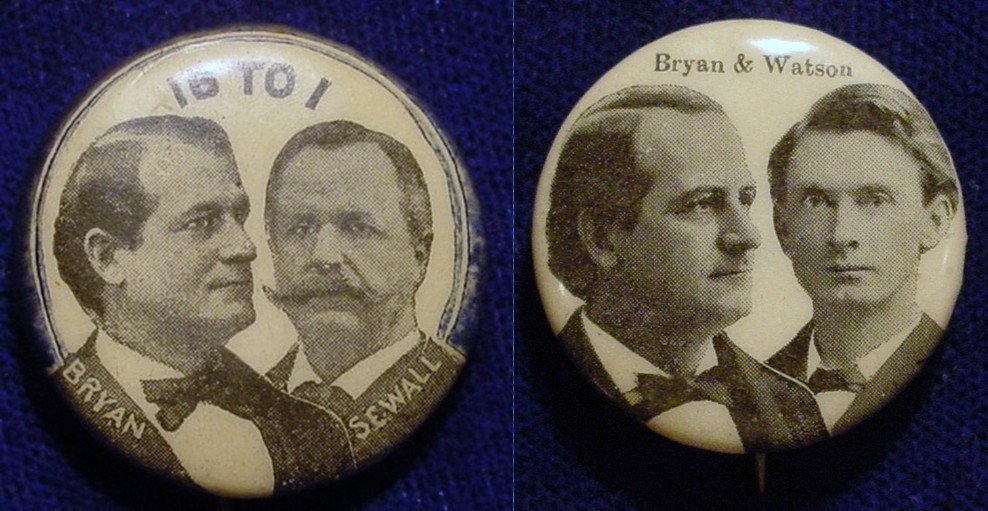
William Jennings Bryan received the presidential nomination from the Democratic and Progressive Parties. The Progressives could not stand his Democratic running mate, Arthur Sewall, who was a Maine ship builder and very successful business man. They nominated Thomas Watson, a radical newspaper publisher, instead.
Teller and 33 others bolted the Republican Convention and formed their own party. At first the Silver Republicans nominated Teller for president, but he refused to embrace the offer. At the Silver Republican Convention, which run simultaneously with Populist Party Convention, the Silver Republicans nominated William Jennings Bryan for president. The Populists, who had first come on the scene in 1891, also nominated Bryan, but they offered an alternative candidate for vice president. The Democrats had selected company owner and Maine shipbuilder, Arthur Sewell, for the second spot. The Populists rejected the business man and nominated former congressman, lawyer and radical newspaper publisher, Thomas Watson, instead. Bryan had the endorsement of three parties and two running mates.
In the general election, William McKinley won the presidency with 7.1 million popular votes and 271 votes in the Electoral College. Bryan received 6.5 million popular votes and 176 votes in the Electoral College.
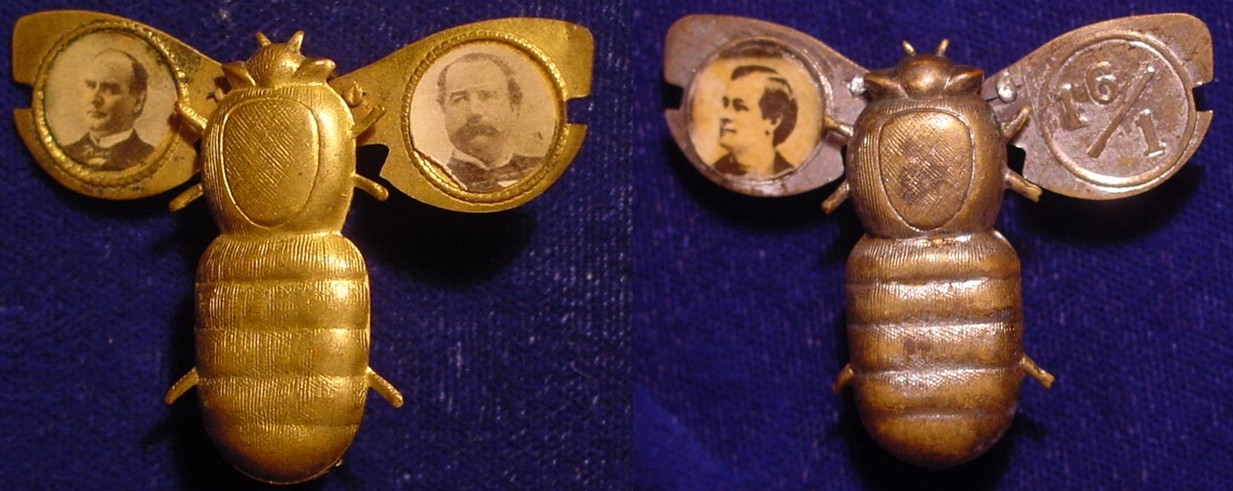
People who supported William McKinley and the Gold Standard were called "gold bugs." Those who supported William Jennings Bryan and the call for the bimetallic 16 to 1 policy were called "silver bugs." The two images were commonly seen on 1896 campaign items.
These "bugs" had mechanical wings that flew out when a button was pushed. The gold bug featured William McKinley and his running mate, Garret Hobart. The silver bug only has a picture of Bryan and “16 to 1” on the other wing because Bryan had two different running mates. The "silver bug" is a much scarcer piece.
Comments
So they finally ended up making coins out of junk.
There's a message there.
Great political/coin history @BillJones.... Thanks for a very interesting post. Cheers, RickO
Fascinating stuff. I didn't know about the splinter parties and their alternate conventions and candidates. Seems highly appropriate that a McKinley gold dollar commemorative was eventually issued.
For what it's worth, I've read that the tension of that era between the gold standard and silver standard formed an allegorical framework to the original writing of the Wizard of Oz. The "yellow brick road" represented the gold standard. "Oz" stands for Ounce. In the original book Dorthy's slippers were silver, but the movie made them ruby. In the original, the Emerald City required people to were green glasses so everything looked green (probably referring to the color of money). So the Emerald City and its Wizard of OZ were not all they tried to appear to be. Dorthy represented the common folk trapped in all this. The scarecrow represented farmers, the tinman represented industrial workers, and the cowardly lion represented William Jennings Bryan who was a coward with a fierce roar.
As I recall from my past readings, this allegory was never completely affirmed by the author, but he was political and interested in the gold-versus-silver debate. It all makes sense and explains so much. ...and it ties in to the gold-vs-silver controversy that was being debated back then.
My strategy is about collecting what I intend to keep, not investing in what I plan to sell.
How fascinating! This is exactly the reason why I love numismatics - the history. (oh, and the coins too! )
)
Instagram - numismatistkenny
My Numismatics with Kenny Blog Page Best viewed on a laptop or monitor.
ANA Life Member & Volunteer District Representative
2019 ANA Young Numismatist of the Year
Doing my best to introduce Young Numismatists and Young Adults into the hobby.
At first Congress thought about issuing a McKinley commemorative silver dollar in 1916-7, but then they remembered the stand McKinley took in the 1896 and 1900 campaigns and made it into a gold piece.
There was a time when McKinley supported bi-metalism as shown by this stud issued when he ran for Congress. The possibility of running for higher office can change one's positions.
Great pieces. These look like they were made by the same person / company.
Thanks much for a very interesting and educational thread. It's strange that the one 1896 button shows a gold dollar which had stopped being produced in 1889. A gold quarter eagle or half eagle would have made more sense. I guess they wanted both the silver dollar and the gold coin to have the same denomination.
Worry is the interest you pay on a debt you may not owe.
"Paper money eventually returns to its intrinsic value---zero."----Voltaire
"Everything you say should be true, but not everything true should be said."----Voltaire
Most die sinkers of the 19th Century put their personal politics aside when it came to making product (and by extension, profit). Many of the presidential campaign tokens listed in the standard DeWitt - Sullivan reference were struck as companion pieces with a portrait piece of the candidate of one party sharing a common reverse with a similar portrait piece of the opposing party candidate. One example of many is from the 1864 campaign where the McClellan token GMcC 1864-10 is a companion to Lincoln token AL 1864-5. Along with the gold & silver bugs shown in the thread above, the tilting head eagle mechanical companion medals are the best known examples from the McKinley - Bryan contest.
Quite an interesting thread, with some pieces that I have not seen before.
RMR: 'Wer, wenn ich schriee, hörte mich denn aus der Engel Ordnungen?'
CJ: 'No one!' [Ain't no angels in the coin biz]
They were made by the same company. I will have to research the source.
The button and political items makers frequently made pieces for both sides. Quite often these pieces would have a similar look or design. These companies were in business to make money, not take political positions.
Here are two sample cards of buttons from the 1940 presidential campaign that were issued by the Green Duck Company. This is an example of a campaign button company making pieces for the both sides.
Here is the Wendel Willkie card:
And here is the card of buttons for Franklin Roosevelt.
Here is a brief history of the Green Duck Company. Its products are big favorites among many political items collectors. And yes, I think that these two cards are scarce items. I have seen very few of them.
The Green Duck Company was founded in Chicago in 1906 by George G. Greenburg (Who had worked for the Childs & Company token making firm.) and Harvey Ducgheisel (a German name). The firm was first called “Greenduck” but ultimately went under the name, “The Green Duck Metal Stamping Company.” The firm made tokens, medals and badges but became best known for their political buttons.
The firm was sold in 1962 and moved to Hernando, Mississippi. There it produced Mardi Gras doubloons and casino chips. It was sold again but was unable to remain in business. The firm closed in 2004.
Thank you for this thread Bill. Learned a lot. Love the bugs.
My 1866 Philly Mint Set
Here we go...another political thread.
There are some great tokens and medal from that era as well.
I have a button and some printed materials that proclaim "NO THIRD TERM", as 1940 was FDR's third presidential campaign.
thank you for your post
POST NUBILA PHOEBUS / AFTER CLOUDS, SUN
Love for Music / Collector of Dreck
Here are some pro-Willkie buttons that made light of the "No Third Term" theme.
And here a couple of Franklin Roosevelt rebuttal buttons.
One con make quite a collection of these "back and forth" 1940 campaign buttons. The specialists say that there are about 900 varieties of the of the Willkie buttons. FDR issued far fewer of them.
In the interest of equal time, an FDR button from that campaign:
EDIT: Posted prior to Bill Jones amending his post to include it.
That's some good stuff!
And a reminder that politics has always been nasty...
Some of the 19th century races were dirtier than they are now. For example, some Andrew Jackson supporters accused John Quincy Adams of acting as a pimp to ruin the virtue of a young woman to satisfy the lusts of the Tsar of Russia in 1828.
The Adams people claimed that Jackson's wife Rachel was a bigamist. Technically it was true because Jackson and Rachel needed an act by the Tennessee Legislature to complete Rachel’s divorce from her former husband. They did not realize that, and quickly remedied the situation. After Rachel died of a heart attack soon after that, Jackson carried a hate for his enemies that burned with a white hot fury. He might have hanged Henry Clay if he had had the chance
To paraphrase Alice Roosevelt Longworth... The grass roots support for Wendel Willkie has its origins in the finest country clubs in America.
And to be fair Willkie was brilliant and very capable. Unfortunately he died prematurely in 1944 well before the 1944 Republican Convention.
Experience the World through Numismatics...it's more than you can imagine.
I like the Bryan Watson pin... What a terrific historical item.
Experience the World through Numismatics...it's more than you can imagine.
Just be happy we're not having them made in China.
Great transactions with oih82w8, JasonGaming, Moose1913.
I have seen very few examples of that piece. It is known in a couple of sizes. This is the smaller one. I found that one at a south Florida political buttons show.
Somehow, I actually have 2 of these bronze political buttons. Peace Roy
BST: endeavor1967, synchr, kliao, Outhaul, Donttellthewife, U1Chicago, ajaan, mCarney1173, SurfinHi, MWallace, Sandman70gt, mustanggt, Pittstate03, Lazybones, Walkerguy21D, coinandcurrency242 , thebigeng, Collectorcoins, JimTyler, USMarine6, Elkevvo, Coll3ctor, Yorkshireman, CUKevin, ranshdow, CoinHunter4, bennybravo, Centsearcher, braddick, Windycity, ZoidMeister, mirabela, JJM, RichURich, Bullsitter, jmski52, LukeMarshall, coinsarefun, MichaelDixon, NickPatton, ProfLiz, Twobitcollector,Jesbroken oih82w8, DCW
Here are both sides of the McKinley medalet I showed in the OP. The reverse is inspired by the Ohio State Seal. This piece was issued at the "end of the golden age of American political medalets." Soon after the beautiful artwork and rice finishes pretty much became a thing of the past.
Great post! These are my favorite type of threads. Love the history behind each item.
ANA-LM, CWTS-LM, NBS, TAMS, ANS